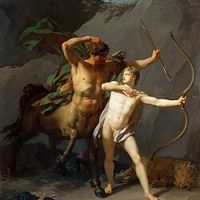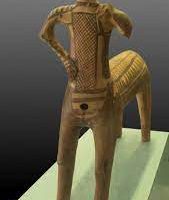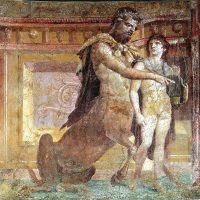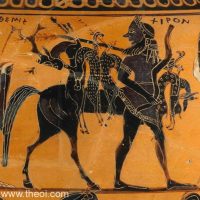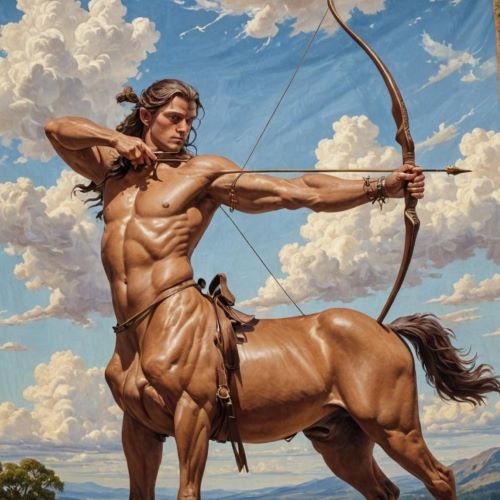Chiron : The Wise Centaur
Listen
At a glance
| Description | |
|---|---|
| Origin | Greek Mythology |
| Classification | Hybrids |
| Family Members | Cronus (Father), Philyra (Mother), Chariclo (Wife), Hippe, Endeis, Ocyrhoe, and Carystus (Choldren) |
| Region | Greece |
| Associated With | Teaching, Wisdom |
Chiron
Introduction
Chiron is one of the most remarkable figures in Greek mythology, a centaur who embodied wisdom, healing, and mentorship. Unlike the rowdy and often destructive nature of other centaurs, Chiron stood apart for his compassion and intellect. He was immortal, born of divine parentage—his father was the Titan Cronus, and his mother was the sea nymph Philyra. Yet, despite his powerful lineage, Chiron’s life was marked by suffering, sacrifice, and the selfless act of guiding others. His presence in myth represents not only a teacher of heroes but also the archetype of the “wounded healer,” a concept that continues to influence psychology, education, and modern spirituality.
Physical Traits
Depictions of Chiron in art and literature emphasize his difference from ordinary centaurs. While most of his kind had the torso of a man seamlessly joined to the body of a horse, Chiron was often shown with more humanized features, including human forelegs. This detail symbolized his higher nature and refinement, setting him apart from the unruly centaur tribes. Artists frequently portrayed him with a dignified beard, sometimes clothed in robes, a stark contrast to the wild nudity associated with his counterparts. His hybrid body served as a metaphor for the balance between instinct and intellect—an immortal being grounded in the natural world but elevated by wisdom and culture.
Family
Chiron’s origins were both divine and tragic. Cronus, in an attempt to evade detection by his wife Rhea, transformed into a horse and united with the nymph Philyra. From this union came Chiron, whose centaur form caused his mother such shame that she abandoned him. He was later fostered by Apollo, the god of music, medicine, and prophecy, who instilled in him the arts of healing, archery, and divination. Chiron married the nymph Chariclo, with whom he fathered several children, including Hippe, Endeïs, Ocyrhoe, and Carystus. His family life reflects a rare tenderness among mythological beings, though even his children were often caught up in the tragic currents of Greek myth.
Other names
In Greek texts, Chiron is also referred to as Cheiron or Kheiron (Χείρων). The name itself is significant, linked to the Greek word “cheir,” meaning “hand.” This connection underscores his mastery of manual arts such as surgery, healing, and teaching through hands-on knowledge. He was often described with epithets like “the wisest of centaurs” or “the justest of centaurs,” phrases that reinforced his role as a moral and intellectual guide. Unlike other mythic figures who accumulated many alternative names, Chiron’s identity remained consistent, emphasizing clarity and authority in his role as a cultural symbol.
Powers and Abilities
Chiron’s skills made him one of the most influential teachers in all of Greek mythology. He was a master physician, credited with introducing the use of medicinal herbs and pioneering the practice of surgery. His abilities extended beyond medicine to include music, prophecy, hunting, and the martial arts. On Mount Pelion, he trained some of the greatest heroes of Greece: Achilles learned endurance and combat skills; Asclepius mastered healing; Jason gained leadership and strategy; and Heracles received crucial guidance before embarking on his labors.
Chiron’s fate, however, highlighted a poignant paradox. During a skirmish involving Heracles, he was struck by an arrow dipped in the Hydra’s venom. The wound was incurable, even with his vast knowledge of medicine. Though immortal, the agony was unbearable, and Chiron chose to surrender his immortality to free Prometheus from his eternal punishment. In honor of his sacrifice, Zeus placed him among the stars, often identified with the constellation Sagittarius or, in some traditions, Centaurus. His story thus bridges knowledge, suffering, and transcendence.
Modern Day Influence
Chiron’s legacy reaches far beyond the boundaries of Greek mythology. In psychology, he serves as the prototype of the “wounded healer,” a term popularized by Carl Jung. This idea suggests that those who experience deep wounds in their own lives are uniquely capable of guiding others through healing. Therapists, counselors, and educators often find in Chiron’s story a mirror of their own role in society.
In astrology, Chiron gained renewed prominence after the discovery of the minor planet 2060 Chiron in 1977. Astrologically, Chiron represents the areas of deep emotional pain that also serve as gateways to growth and transformation. It has become a central concept in modern spiritual and psychological practice, symbolizing the path from suffering to healing.
Chiron also features prominently in popular culture. He appears as a central mentor figure in Rick Riordan’s Percy Jackson series, where his role as a guide for young heroes is reimagined for contemporary readers. Beyond literature, Chiron’s name is invoked in scientific fields, medical contexts, and discussions of education, reinforcing his enduring influence.
Related Images
Source
Encyclopaedia Britannica. (1998, July 19). Chiron | Centaur, Healer, Teacher. Retrieved from https://www.britannica.com/topic/Chiron-Greek-mythology
Wikipedia. (2002, February 27). Chiron. In Wikipedia. Retrieved from https://en.wikipedia.org/wiki/Chiron
Centre of Excellence. (2025, June 11). Chiron in Greek Mythology: Myths, Powers, and Symbols. Retrieved from https://www.centreofexcellence.com/chiron-in-greek-mythology/
GreekMythology.com. (n.d.). Chiron. Retrieved from https://www.greekmythology.com/Myths/Creatures/Chiron/chiron.html
Miller, M. (2018, February 22). Myth of the Week: Chiron. Retrieved from https://madelinemiller.com/myth-of-the-week-chiron/
Theoi.com. (n.d.). CHIRON (Kheiron) – Elder Centaur of Greek Mythology. Retrieved from https://www.theoi.com/Georgikos/KentaurosKheiron.html
Psychology Today. (2025, January 7). The Myth of Chiron, the Wounded Healer. Retrieved from https://www.psychologytoday.com/gb/blog/hide-and-seek/202102/the-myth-of-chiron-the-wounded-healer
Ancient Origins. (n.d.). Chiron, the Noble Elder Centaur of Greek Mythology. Retrieved from https://www.ancient-origins.net/myths-legends-europe/chiron-0017432
Graves, R. (1955). The Greek Myths. Penguin Books.
Kerenyi, C. (1951). The Gods of the Greeks. Thames and Hudson.
Jung, C. G. (1964). Man and His Symbols. Doubleday.
Riordan, R. (2005). Percy Jackson & the Olympians: The Lightning Thief. Disney-Hyperion.
Clow, B. H. (1996). Chiron: Rainbow Bridge Between the Inner and Outer Planets. Llewellyn Publications.
Frequently Asked Questions
What is lorem Ipsum?
I am text block. Click edit button to change this text. Lorem ipsum dolor sit amet, consectetur adipiscing elit. Ut elit tellus, luctus nec ullamcorper mattis, pulvinar dapibus leo.
What is lorem Ipsum?
I am text block. Click edit button to change this text. Lorem ipsum dolor sit amet, consectetur adipiscing elit. Ut elit tellus, luctus nec ullamcorper mattis, pulvinar dapibus leo.
What is lorem Ipsum?
I am text block. Click edit button to change this text. Lorem ipsum dolor sit amet, consectetur adipiscing elit. Ut elit tellus, luctus nec ullamcorper mattis, pulvinar dapibus leo.
What is lorem Ipsum?
I am text block. Click edit button to change this text. Lorem ipsum dolor sit amet, consectetur adipiscing elit. Ut elit tellus, luctus nec ullamcorper mattis, pulvinar dapibus leo.
What is lorem Ipsum?
I am text block. Click edit button to change this text. Lorem ipsum dolor sit amet, consectetur adipiscing elit. Ut elit tellus, luctus nec ullamcorper mattis, pulvinar dapibus leo.


